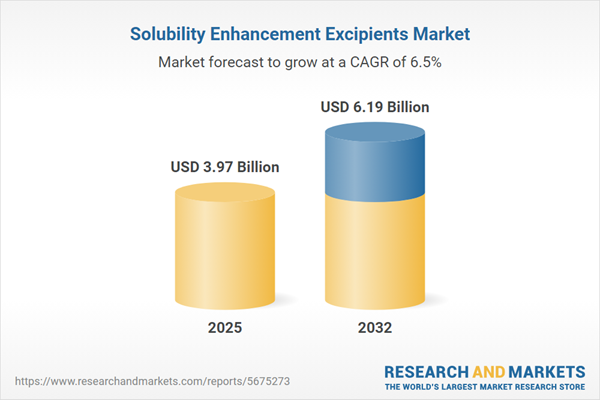Speak directly to the analyst to clarify any post sales queries you may have.
The solubility enhancement excipients market is gaining strategic significance, as pharmaceutical companies increasingly rely on these solutions to improve drug bioavailability and streamline product development pipelines. This research provides detailed insights to empower senior executives with data-driven decisions in a sector marked by rapid innovation and evolving global dynamics.
Market Snapshot: Solubility Enhancement Excipients Market
The Solubility Enhancement Excipients Market grew from USD 3.74 billion in 2024 to USD 3.97 billion in 2025 and is projected to reach USD 6.19 billion by 2032, registering a 6.47% CAGR. Industry growth is fueled by the demand for innovative excipients, new formulation strategies, and the transformation of supply chains. As drug pipelines include increasingly complex molecules, excipients that optimize solubility have become essential in delivering improved patient outcomes and enabling advanced drug delivery mechanisms.
Scope & Segmentation
This report analyzes the solubility enhancement excipients sector across technology, application, and geography, offering actionable intelligence across the following domains:
- Types: Cyclodextrins (Alpha, Beta, Gamma), Hydrophilic Polymers (Hydroxypropyl methylcellulose, PEG, Polyvinyl alcohol, PVP), Lipophilic Excipients (Fatty Acids, Lecithins, Surfactants), Solid Dispersion Agents (Maltodextrin, Mannitol, Sorbitol), Surfactants.
- Functionality: Bioavailability Enhancers, Release Modifiers, Solubility Enhancers, Stabilizers.
- Route of Administration: Injectable, Oral, Topical, Transdermal Drug Delivery.
- Source: Natural Excipients, Synthetic Excipients.
- Form: Liquid, Powder.
- Dosage Form: Inhalation, Injectable, Oral, Topical Formulations.
- Application: Cosmetics & Personal Care, Nutraceuticals, Pharmaceuticals.
- Regions: Americas (United States, Canada, Mexico, Brazil, Argentina, Chile, Colombia, Peru), Europe (United Kingdom, Germany, France, Russia, Italy, Spain, Netherlands, Sweden, Poland, Switzerland), Middle East (UAE, Saudi Arabia, Qatar, Turkey, Israel), Africa (South Africa, Nigeria, Egypt, Kenya), Asia-Pacific (China, India, Japan, Australia, South Korea, Indonesia, Thailand, Malaysia, Singapore, Taiwan).
- Leading Companies: ABITEC Corporation, Air Liquide S.A., Ashland Global Holdings Inc., BASF SE, Cargill, Incorporated, Clariant International Ltd., Croda International PLC, DuPont de Nemours Inc., Evonik Industries AG, FMC Corporation, FREUND Corporation, Gattefossé, IMCD Group, JRS Pharma GmbH & Co. KG, Kerry Group PLC, Lubrizol Corporation, Merck KGaA, Nippon Soda Co. Ltd., Pharma Excipients International AG, Roquette Freres SA, Shin-Etsu Chemical Co., Ltd., Solvay SA, SPI Pharma Inc., The DOW Chemical Company, Wacker Chemie AG.
Key Takeaways for Decision Makers
- Solubility enhancement excipients have shifted from commodity ingredients to vital enablers in unlocking novel therapies, expediting clinical timelines, and bolstering product differentiation.
- Advances in nanotechnology, cyclodextrin chemistry, and high-throughput formulation screening are driving next-generation product development, reducing the risk of late-stage failures.
- Collaborative approaches by manufacturers, contract development organizations, and academia are accelerating innovation cycles and knowledge sharing.
- Emerging delivery platforms and predictive modeling tools are streamlining excipient selection and regulatory compliance, strengthening supply chain resilience.
- Sustainability goals, such as bio-based polymers and greener manufacturing, are aligning with client and regulatory expectations, supporting long-term competitiveness.
- Regional variations in infrastructure and regulatory standards require suppliers and buyers to tailor sourcing, product offerings, and go-to-market strategies to specific local market conditions.
Impact of 2025 U.S. Tariff Measures
The introduction of new U.S. tariffs is placing upward pressure on costs for cyclodextrins, hydrophilic polymers, and surfactants. Manufacturers are responding with dual-sourcing, supplier diversification, and alternative excipient classes. Regional players are leveraging the environment to scale capacity and form strategic collaborations, promoting local supply resilience and fostering excipient innovation at scale.
Solubility Enhancement Excipients Market: Methodology & Data Sources
The analysis draws on rigorous secondary research, structured stakeholder interviews, and cross-validation of quantitative data. Peer-reviewed publications, regulatory filings, and industry reports ground market insights, while advanced analytics and continuous industry expert feedback ensure reliability and currency of findings.
Why This Report Matters to Senior Leaders
- Benchmark product, technology, and supplier strategies to ensure alignment with emerging regulatory, sustainability, and market trends.
- Anticipate risk and opportunity in tariff and supply chain shifts, helping safeguard continuity in vital ingredient sourcing.
- Enable proactive, evidence-based portfolio decisions in a market where excipient differentiation shapes therapeutic and commercial success.
Conclusion
Senior decision-makers will gain the clarity needed to adapt to evolving excipient market conditions, regional dynamics, and digital transformation. In a sector where formulation agility and supply resilience shape outcomes, robust insight translates into sustainable competitive advantage.
Additional Product Information:
- Purchase of this report includes 1 year online access with quarterly updates.
- This report can be updated on request. Please contact our Customer Experience team using the Ask a Question widget on our website.
Table of Contents
3. Executive Summary
4. Market Overview
7. Cumulative Impact of Artificial Intelligence 2025
Companies Mentioned
The companies profiled in this Solubility Enhancement Excipients market report include:- ABITEC Corporation
- Air Liquide S.A.
- Ashland Global Holdings Inc.
- BASF SE
- Cargill, Incorporated
- Clariant International Ltd.
- Croda International PLC
- DuPont de Nemours Inc.
- Evonik Industries AG
- FMC Corporation
- FREUND Corporation
- Gattefossé
- IMCD Group
- JRS Pharma GmbH & Co. KG
- Kerry Group PLC
- Lubrizol Corporation
- Merck KGaA
- Nippon Soda Co. Ltd.
- Pharma Excipients International AG
- Roquette Freres SA
- Shin-Etsu Chemical Co., Ltd.
- Solvay SA
- SPI Pharma Inc.
- The DOW Chemical Company
- Wacker Chemie AG
Table Information
| Report Attribute | Details |
|---|---|
| No. of Pages | 197 |
| Published | November 2025 |
| Forecast Period | 2025 - 2032 |
| Estimated Market Value ( USD | $ 3.97 Billion |
| Forecasted Market Value ( USD | $ 6.19 Billion |
| Compound Annual Growth Rate | 6.4% |
| Regions Covered | Global |
| No. of Companies Mentioned | 26 |









